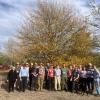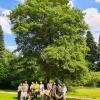Editor's Picks
Plant Focus
Idan Kopler and Oded Bar-Shalom
Published May 2019 in International Oaks No. 30: 161–168
Abstract
Forest tree decline has been reported worldwide and in Israel, and is related to regional and global climate change. In Israel, oak (Quercus spp.) decline has been documented in the Jerusalem Mts. in Galilee and in the Carmel.
Our research goal is to characterize the health status of oak populations in the Golan Heights under regional stress factors. This was achieved using three plots through stand structure survey and monitoring the water regime of oaks in various stages of decline. In total, 962 oaks were sampled to examine rates of decline during 2016-2017. Negligible measures of decline and a lack of tree mortality were observed in the northern Golan. Total canopy loss of almost 20% and high measures of Quercus ithaburensis (Tabor oak) mortality were recorded in the central and southern Golan populations. Midday stem water potential values were significantly lower in symptomatic trees, though only in the Q. ithaburensis woodlands. At the plot scale, the lack of a significant difference in the mean stem water potential between healthy and symptomatic trees indicates a large hydraulic plasticity.
Keywords
stem water potential, Quercus calliprinos, Quercus coccifera subsp. calliprinos, Quercus ithaburensis, Quercus boissieri, Quercus infectoria subsp. veneris
References
Adams, H.D., C.H. Luce, D.D Breshears, C.D. Allen, M. Weiler, V.C. Hale, A.M.S. Smith, and T.E. Huxman. 2012. Ecohydrological consequences of drought‐ and infestation‐triggered tree die‐off: insights and hypotheses. Ecohydrology 5(2): 145-59.
Allen, C.D., A.K. Macalady, H. Chenchouni, D. Bachelet, N. McDowell, M. Vennetier, T. Kitzberger, A. Rigling, D.D. Breshears, E.H..T. Hogg, P. Gonzalez, R. Fensham, Z. Zhang, J. Castro, N. Demidova, J.-H. Lim, G. Allard, S.W. Running, A. Semerci, and N. Cobb. 2010. A global overview of drought and heat-induced tree mortality reveals emerging climate change risks for forests. Forest ecology and management 259(4): 660-684.
Anderegg, W.R.L., J.M. Kane, and L.D.L. Anderegg. 2013. Consequences of widespread tree mortality triggered by drought and temperature stress. Nature Climate Change 3: 30-36. doi: 10.1038/NCLIMATE1635
Chone, X., C. Van Leeuwen, D. Dubourdieu, and J.P. Gaudillère. 2001. Stem Water Potential is a Sensitive Indicator of Grapevine Water Status. Annals of Botany 87(4): 477-483.
Hacket-Pain, A.J., L. Cavin, A.D. Friend, and A.S. Jump. 2016. Consistent limitation of growth by high temperature and low precipitation from range core to southern edge of European beech indicates widespread vulnerability to changing climate. European Journal of Forest Research 135(5): 897-909.
Herr, N. 2009. Dehydration and mortality of Tabor oak trees from natural sources in settlements and forests (in Hebrew). Published online at www.nirforestecosoil.com/oaks-dehdration
Israel Hydrological Service. 2016. http://geocradle.eu/platform/stakeholder/israeli-hydrological-service/
McDowell, N.G., Fisher, R.A., C. Xu, J.C. Domec, T. Hölttä, D.S. Mackay, J.S. Sperry, A.Boutz, L. Dickman, N. Gehres, J.M. Limousin, A. Macalady, J. Martínez-Vilalta, M. Mencuccini, J.A. Plaut, J. Ogée, R.E. Pangle, D.P. Rasse, M.G. Ryan, S. Sevanto, R.H. Waring, A. P. Williams, E.A. Yepez, and W.T. Pockman. 2013. Evaluating theories of drought-induced vegetation mortality using a multimodel–experiment framework. New Phytologist 200(2): 304-321.
Navon, Y., L. Hadar, H. Muklada, and J. Grünzweig. 2015. Long Term Oak monitoring in Ramat Hanadiv 2009-2015. Published online at www.ramat-handav.org.
Sever, N., and G. Neeman. 2008. Dehydration and recovery of Quercus calliprinos in Israel following consecutive drought years. Yaar 10: 10-16.
Thomas, F.M. 2008. Recent advances in cause-effect research on oak decline in Europe. CAB Reviews: Perspectives in Agriculture, Veterinary Science, Nutrition and Natural Resources 3 (037): 1-12.
Thomas, F.M., R. Blank, and G. Hartmann. 2002. Abiotic and biotic factors and their interactions as causes of oak decline in Central Europe. Forest Pathology 32: 277-307.















